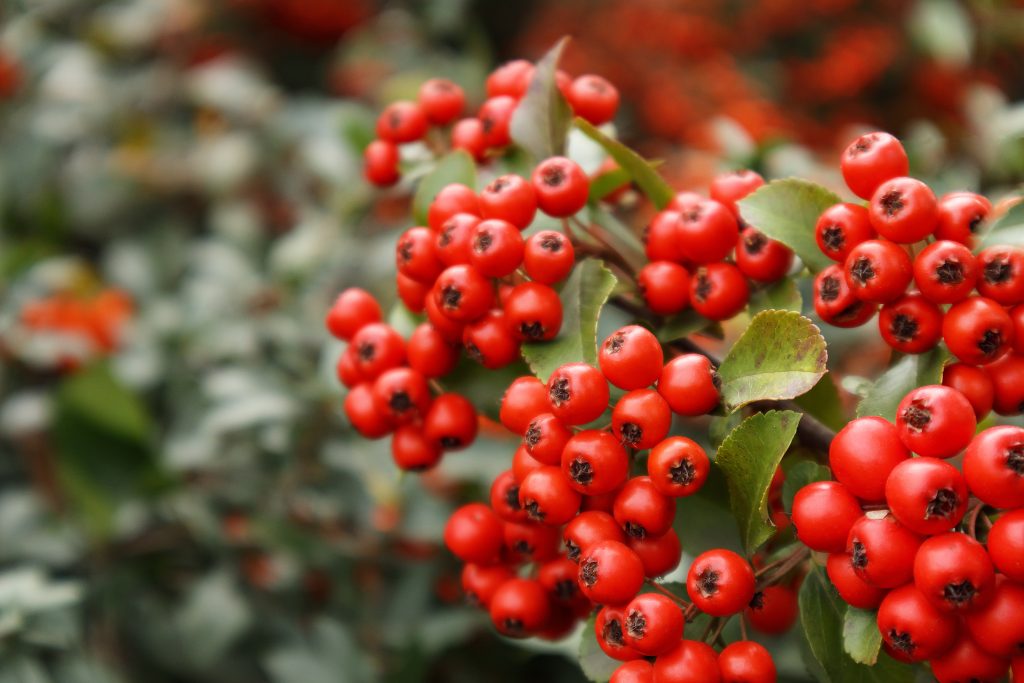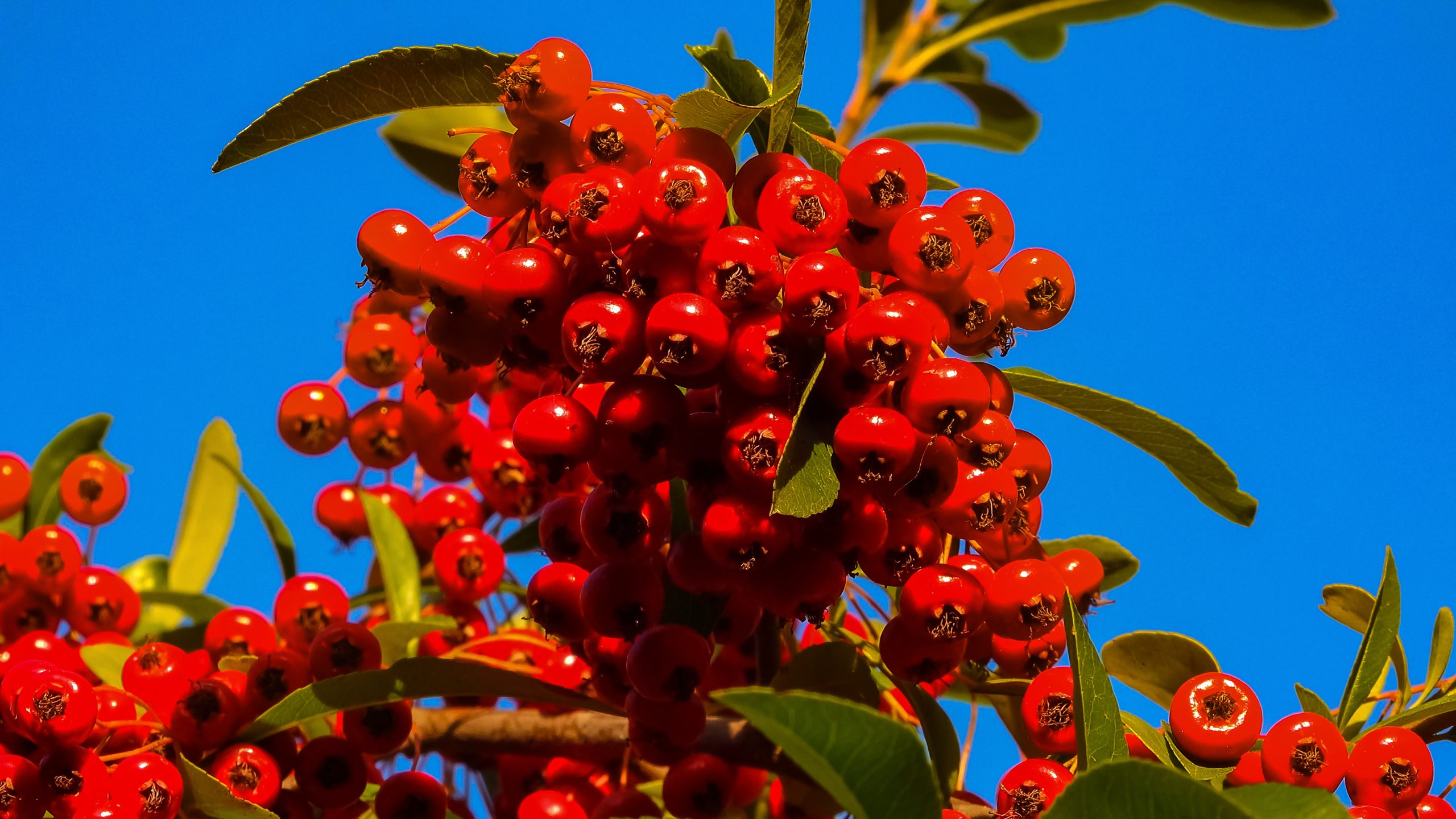Firethorns are a wild berry-like pome fruit that thrives in most climates. While the raw fruits are very bitter, the flavors transform into something unique when cooked. Keep reading to learn why the birds can’t get enough of these beautiful red firethorn berries.
Table of Contents
What is Firethorn?
The firethorn evergreen shrub is a native European and Asian flowing plant that produces edible pomes called firethorns. In the spring, they create beautiful white flowers that mature into fire-red pomes that grow in large clusters. It’s also known as scarlet firethorn, fire blight, or Formosa firethorn.
As a member of the rose family, like pears, apples, and cherries, each firethorn pome has a seed that is not edible. The fruit around the seed can be consumed raw or made into jelly or jam, but you must throw away those seeds! The flavor of these raw red berries is quite bitter and alkaline, but once cooked into jelly, it becomes sweet, like apple butter.
The History of Firethorn
The firethorn bush (Pyracantha coccinea) has been a food source for wildlife for over 25 million years. Fossil records of this ancient seed were discovered and dated to the middle Miocene strata era, ranging from 5 million to 25 million years ago.
While its original home is in Denmark, it became popularized by European landscapers for its beautiful flowers in late spring, decorative dark green leaves, and edible red fruits. In the 1600s, cultivars used this bush in European gardens in full sun as an ornamental hedge; some could grow as tall as 15 feet.

What Does Firethorn Taste Like?
Leave the raw firethorns for the birds! Raw firethorns are not very appetizing; when consumed raw, they have a very bitter flavor that some find astringent.
However, that bitterness fades away the moment you cook these red berries into dishes like jams and jellies. Once cooked, firethorns transform into something delicately sweet and savory. Many describe the flavor of cooked firethorns as apple butter.
How to Tell When Firethorn is Ripe
So, how can you tell if a firethorn is ready to be plucked from the bush? Luckily, there are a few easy ways to tell when they’re ready for harvest.
| Color | As the firethorn matures, it transforms from yellow berries to orange berries and finally to a fire-red berry. Wait until late summer when it reaches its deepest shade of red. |
| Firmness | The texture of ripe firethorns changes ever so slightly. As they mature, the flesh becomes a little softer than unripe. If it feels plump to the touch, it’s ready to be snipped from the bush. |
| Smell | Because firethorns aren’t sweet and lovely at the peak of ripeness, the scent test isn’t ideal for gauging ripeness. |
| Bruising | If you find your berries are overly bruised, they are over-ripe. Toss them. |
It’s important to note that when harvesting firethorns right from the bush, you must act fast. The moment you see a neighboring bird pecking at them, they’re ripe! If you wait a few days, the birds love to make quick work of ripe firethorns.
Can I Eat Raw Firethorn?
Yes, you can eat raw firethorns, although the flavors are slightly less than ideal. When eating raw firethorns, you must always discard the seeds. Like other members of the rosacea family, the seeds of firethorns are unsafe for consumption.
Eating raw firethorn berries may cause uncomfortable gastrointestinal distress. While you can technically eat them raw, they are much better when cooked!
Cooking with Firethorn
Before you can get a little jammy, you must first know how to prepare your firethorns properly.
1. Wash them. Place firethorns into a colander, and run cool water over them to remove dirt and debris. If you notice any brown or bruised firethorn, toss them.
2. Remove the seeds. This is the most crucial step! If you have a cherry pitter, you can poke out the seed from the skin. If you don’t have a cherry pitter, use a skewer to poke through the center of the berry to remove the seed.

Firethorn Jelly: One of the best uses for these early summer berries is to make a jelly that will last all winter! This recipe incorporated the subtle sweetness of cooked firethorns with a hint of acidity from lemon and grapefruit.
Firethorn Jam: This recipe is fantastic if you aren’t a grapefruit fan and don’t like your jams overly sweet! It adds a bit of lemon juice for acidity and not as much sugar. It tastes mild, like savory apple butter, and is 100 percent delicious.
How to Store Firethorn
Firethorns and cherries have a lot in common, including their storage methods. After they are harvested, they will stay fresh in the fridge for up to one week.
If you want to extend the life of your berries slightly, you can also pit them and store them in the freezer for up to one year. However, the best way to preserve your firethorns is by whipping them into a delicious jam.
Nutritional Benefits of Firethorn
These showy semi-evergreen bushes provide much more than decorative landscaping and delicious jam. They are also a great source of vitamin C, Vitamin E, and flavonoids.
Diets rich in Vitamin C help to boost your immune system, help to maintain healthy glowing skin and promotes bone and cartilage health. Flavonoids are also an excellent addition to your diet. As a powerful antioxidant, flavonoids reduce the risk of cancer, reduce inflammation, and have antiviral properties.
Where to Purchase Firethorn
Unfortunately, firethorns are unlikely to be available at your local market. However, you have a few options.
Since these evergreen bushes are hardy and thrive in various climates (even in hardiness zones in the US), you could grow a few bushes in your backyard and harvest your berries later in the summer. Another great option is to head down to your local farmers market when firethorns are in season between late spring and early summer.

